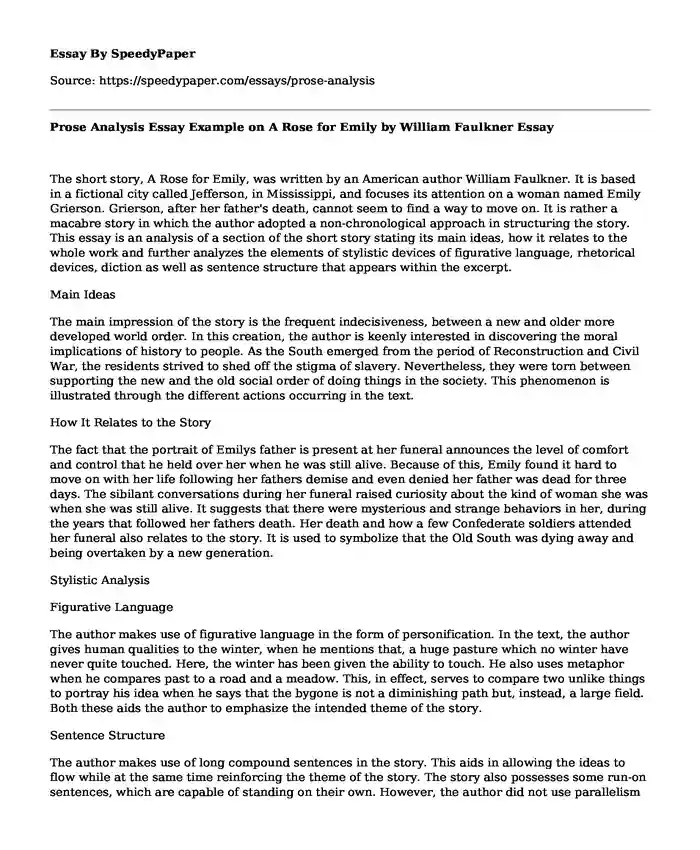
| Type of paper: | Essay |
| Categories: | Literature Analysis William Faulkner |
| Pages: | 3 |
| Wordcount: | 813 words |
The short story, A Rose for Emily, was written by an American author William Faulkner. It is based in a fictional city called Jefferson, in Mississippi, and focuses its attention on a woman named Emily Grierson. Grierson, after her father's death, cannot seem to find a way to move on. It is rather a macabre story in which the author adopted a non-chronological approach in structuring the story. This essay is an analysis of a section of the short story stating its main ideas, how it relates to the whole work and further analyzes the elements of stylistic devices of figurative language, rhetorical devices, diction as well as sentence structure that appears within the excerpt.
Main Ideas
The main impression of the story is the frequent indecisiveness, between a new and older more developed world order. In this creation, the author is keenly interested in discovering the moral implications of history to people. As the South emerged from the period of Reconstruction and Civil War, the residents strived to shed off the stigma of slavery. Nevertheless, they were torn between supporting the new and the old social order of doing things in the society. This phenomenon is illustrated through the different actions occurring in the text.
How It Relates to the Story
The fact that the portrait of Emilys father is present at her funeral announces the level of comfort and control that he held over her when he was still alive. Because of this, Emily found it hard to move on with her life following her fathers demise and even denied her father was dead for three days. The sibilant conversations during her funeral raised curiosity about the kind of woman she was when she was still alive. It suggests that there were mysterious and strange behaviors in her, during the years that followed her fathers death. Her death and how a few Confederate soldiers attended her funeral also relates to the story. It is used to symbolize that the Old South was dying away and being overtaken by a new generation.
Stylistic Analysis
Figurative Language
The author makes use of figurative language in the form of personification. In the text, the author gives human qualities to the winter, when he mentions that, a huge pasture which no winter have never quite touched. Here, the winter has been given the ability to touch. He also uses metaphor when he compares past to a road and a meadow. This, in effect, serves to compare two unlike things to portray his idea when he says that the bygone is not a diminishing path but, instead, a large field. Both these aids the author to emphasize the intended theme of the story.
Sentence Structure
The author makes use of long compound sentences in the story. This aids in allowing the ideas to flow while at the same time reinforcing the theme of the story. The story also possesses some run-on sentences, which are capable of standing on their own. However, the author did not use parallelism for the expression effect but rather expressed ideas that are interconnected.
Diction
The author uses a high level of diction as a form of literary language, characterized by the use of concrete words that mostly describe the experiences of the characters. The authors writing is also formal in expressing the theme of the story. Also, the words that the author uses in his writing are pervasively polysyllabic as most of them have their syllables widely spread. There is also a preponderance of describing the mood, atmosphere, and feelings expressed within the story. The verbs used are also passive in nature as most of the characters in the story undergo the actions rather than doing it.
Rhetoric Devices
As a figure of speech, the author has also used alliteration through repetition of the consonant, d, when he says that all the past is not a diminishing road but, instead, a huge meadow. There is also assonance in the authors writing when he uses words like diminishing. These rhetorical devices help to create a smooth flow of words as the passage is being read to increase the readers interest and appeal to the text.
Conclusion
In light of the above, the excerpt expressed some ideas that carried a lot of relevance in the story. The author used several literary devices to express better the theme of the story. The devices included metaphors, personification, and a formal diction. He also used proper sentence structure that clearly express ideas as well as rhetorical devices. These devices proved important, especially since they appeal to the readers and thereby capturing their attention. They also aid the readers to gain a clearer picture of the events occurring within the story. As such, they not only tell the reader what is happening but also give an insight into the feelings of the characters in the story.
Cite this page
Prose Analysis Essay Example on A Rose for Emily by William Faulkner. (2019, Aug 15). Retrieved from https://speedypaper.com/essays/prose-analysis
Request Removal
If you are the original author of this essay and no longer wish to have it published on the SpeedyPaper website, please click below to request its removal:
- The Psychology of Learning, Essay Example
- E-mail Investigation Essay Sample
- Protecting Mother Russia at All Costs - WW1 Essay Example
- Ethnography Essay Example
- Free Essay on the New Historicism and Its Application to Literature
- Aroma Management Report, Free Paper Sample
- Essay Example: Crime or Deviant Behavior
Popular categories




